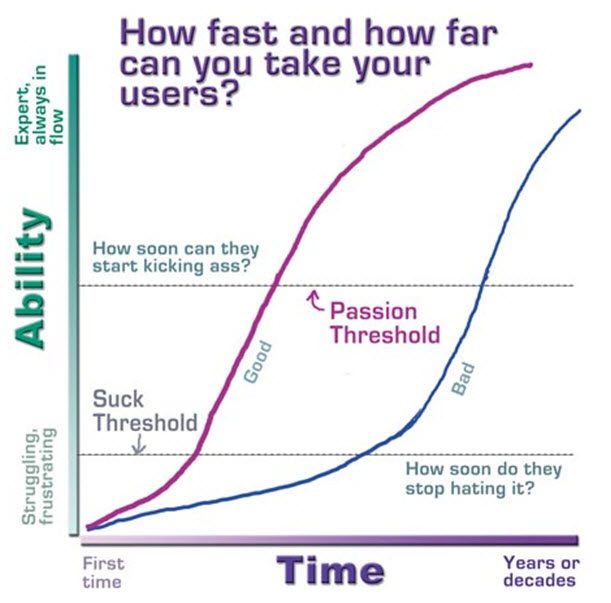Transitioning to the New Normal
Why is change so difficult?
Change is hard because it requires letting go, and possibly giving up some degree of control. Within an organization (and especially within IT groups) change requires recognition of the gap between the philosophical idea of allowing people to manage their own tools and business solution, and the reality that much more hand-holding may actually be needed.
Collaboration (the act of working with others, not the technology) can be a difficult thing for many people to embrace. Successful collaboration takes time, lots of effort and fine-tuning, and — let’s be honest — the modern collaboration tools and techniques can be counterintuitive to the ways in which many businesses run.
Yes, it is an opportunity to once again share one of my all-time favorite images! I’ve included this diagram in dozens of presentations over the years, which comes from the still-online archives from uber-geeky Creating Passionate Users blog: of course, I’m talking about none other than…
The Suck Threshold
 The idea behind this graphic was simple enough: the longer you take to deliver the features your employees want and need, the tougher time you’ll have in winning them over, even if you eventually deliver on all of their asks. I typically use the example of the Microsoft Zune and the Apple iPod. The Zune was by most measurements a superior device and user experience. While the first couple versions were bulky and had limited storage, the later versions were sleek and powerful, and from Day 1 the UX of the software — both on the device and for the linked desktop app — was far superior to iTunes. The Zune had advanced features and the ability to share, and the app was designed for people who love music. However…Microsoft took far too long to deliver their answer to the iPod, and was never able to capture market share — even with a better product and UX.
The idea behind this graphic was simple enough: the longer you take to deliver the features your employees want and need, the tougher time you’ll have in winning them over, even if you eventually deliver on all of their asks. I typically use the example of the Microsoft Zune and the Apple iPod. The Zune was by most measurements a superior device and user experience. While the first couple versions were bulky and had limited storage, the later versions were sleek and powerful, and from Day 1 the UX of the software — both on the device and for the linked desktop app — was far superior to iTunes. The Zune had advanced features and the ability to share, and the app was designed for people who love music. However…Microsoft took far too long to deliver their answer to the iPod, and was never able to capture market share — even with a better product and UX.
Looking at the image with the Zune in mind, they took too long to get their customers from the suck threshold to the passion threshold.
Well, except for me. I have a much lower passion threshold. Or a much higher suck threshold? Suck tolerance level? (I’ve heard it both ways)
This is something to consider as your organization contemplates moving more of your systems to the cloud, and makes decisions about permanently shifting some or all employees to the virtual office. Is this the “new normal?” I’m still on the fence about the long-term for the majority of people, although the pandemic has certainly shown us that there is very little impact to white collar workers.
One area that continues to impact the change from in-person to purely online are security concerns (some real, some not), such as fearing that your employees will use unauthorized tools and services, putting company IP at risk. Back to the Suck Threshold concept — the longer you take to deliver the features your employees need, the more likely your fears will become a reality.
What is driving this cultural change?
The obvious answer today is COVID-19 and most countries enforcing strict quarantines. Many organizations were already moving (albeit slowly) toward the virtual office, but with current global safeguards during this pandemic, I expect most organizations to re-think their remote worker policies even after this quarantine.
Additionally, within the Microsoft customer ecosystem there are many business who want to get more value out of their Microsoft 365 investments, including SharePoint and Microsoft Teams. Within community sites (on the Microsoft Tech Community, Facebook and LinkedIn groups, and regional user group sites) people are talking about and asking questions about all of the great features within these platforms, but many companies are struggling to understand how to get the most out of them. End users are exploring and experimenting out of necessity, presenting a massive opportunity for organizations to take a leadership role with their employees, and develop an adoption and engagement strategy.
Cultural considerations
 As you reflect on the past year, it is always good to review and assess your success and failures in supporting the virtual office with your employees. Take a moment to run a formal post-mortem, and consider your performance and opportunities for improvement across four primary areas:
As you reflect on the past year, it is always good to review and assess your success and failures in supporting the virtual office with your employees. Take a moment to run a formal post-mortem, and consider your performance and opportunities for improvement across four primary areas:
- Business Focus / Productivity. Do people feel more productive? Has the volume of work increased, decreased, or remained the same? Some teams that work very well together can find themselves struggling to maintain performance levels if they feel detached and disconnected.
- Security. Are your systems and data secured, and do people understand how to properly share and collaborate on company assets?
- Lack of Visibility / Transparency. Working remotely may seem like the ideal situation for people who prefer to work independently, but without visibility of what work is being done and how business decisions are being made, it’s easy to go astray. The more you involve people in the process, the more people will support the process.
- Support Issues. Are there adequate feedback mechanisms into every aspect of your business? Do people know where to go to ask questions and provide feedback?
There is no homogenous approach to collaboration. What works in one organization may fail in others, which is why it is so important to get to know your collaboration culture — and to pilot new tools and new approaches. Work with your key stakeholders to outline your core business activities, and the tools and processes you’ll use.




